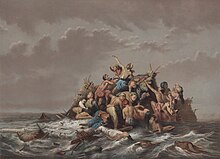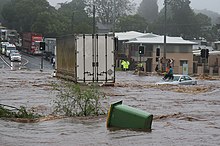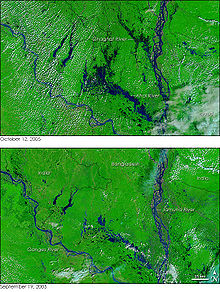Flood







A flood is an overflow of water that submerges land.[1] The European Union (EU) Floods Directive defines a flood as a covering by water of land not normally covered by water.[2] In the sense of "flowing water", the word may also be applied to the inflow of the tide. Flooding may result from the volume of water within a body of water, such as a river or lake, which overflows or breaks levees, with the result that some of the water escapes its usual boundaries.[3]
While the size of a lake or other body of water will vary with seasonal changes in precipitation and snow melt, it is not a significant flood unless such escapes of water endanger land areas used by man like a village, city or other inhabited area.
Floods can also occur in rivers, when flow exceeds the capacity of the river channel, particularly at bends or meanders. Floods often cause damage to homes and businesses if they are placed in natural flood plains of rivers. While flood damage can be virtually eliminated by moving away from rivers and other bodies of water, since time out of mind, people have lived and worked by the water to seek sustenance and capitalize on the gains of cheap and easy travel and commerce by being near water. That humans continue to inhabit areas threatened by flood damage is evidence that the perceived value of living near the water exceeds the cost of repeated periodic flooding.
The word "flood" comes from the Old English flod, a word common to Germanic languages (compare German Flut, Dutch vloed from the same root as is seen in flow, float; also compare with Latin fluctus, flumen). Deluge myths are mythical stories of a great flood sent by a deity or deities to destroy civilization as an act of divine retribution, and are featured in the mythology of many cultures.
Principal types and causes
Riverine
- Slow kinds: Runoff from sustained rainfall or rapid snow melt exceeding the capacity of a river's channel. Causes include heavy rains from monsoons, hurricanes and tropical depressions, foreign winds and warm rain affecting snow pack. Unexpected drainage obstructions such as landslides, ice, or debris can cause slow flooding upstream of the obstruction.
- Fast kinds: include flash floods resulting from convective precipitation (intense thunderstorms) or sudden release from an upstream impoundment created behind a dam, landslide, or glacier.
Estuarine
- Commonly caused by a combination of sea tidal surges caused by storm-force winds. A storm surge, from either a tropical cyclone or an extratropical cyclone, falls within this category.
Coastal
- Caused by severe sea storms, or as a result of another hazard (e.g. tsunami or hurricane). A storm surge, from either a tropical cyclone or an extratropical cyclone, falls within this category.
Catastrophic
- Caused by a significant and unexpected event e.g. dam breakage, or as a result of another hazard (e.g. earthquake or volcanic eruption). See outburst flood.
Human-induced
- Accidental damage by workmen to tunnels or pipes.
Muddy
- A muddy flood is produced by an accumulation of runoff generated on cropland. Sediments are then detached by runoff and carried as suspended matter or bed load. Muddy runoff is more likely detected when it reaches inhabited areas. Muddy floods are therefore a hill slope process, and confusion with mudflows produced by mass movements should be avoided.
Other
- Floods can occur if water accumulates across an impermeable surface (e.g. from rainfall) and cannot rapidly dissipate (i.e. gentle orientation or low evaporation).
- A series of storms moving over the same area.
- Dam-building beavers can flood low-lying urban and rural areas, often causing significant damage.
- linas-sairyua
Effects
Primary effects
Physical damage – damage to structures, including bridges, buildings, sewerage systems, roadways, and canals.
Secondary effects
- Water supplies – Contamination of water. Clean drinking water will become scarce.
- Diseases – Unhygienic conditions. Spread of water-borne diseases.
- Crops and food supplies – Shortage of food crops can be caused due to loss of entire harvest.[4] However, lowlands near rivers depend upon river silt deposited by floods in order to add nutrients to the local soil.
- Trees – Non-tolerant species can die from suffocation.[5]
- Transport – Transport links destroyed, so hard to get emergency aid to those who need it.
Tertiary and long-term effects
Economic – economic hardship due to temporary decline in tourism, rebuilding costs, food shortage leading to price increase, etc.
Control






In many countries across the world, rivers prone to floods are often carefully managed. Defenses such as levees,[6] bunds, reservoirs, and weirs are used to prevent rivers from bursting their banks. When these defenses fail, emergency measures such as sandbags or portable inflatable tubes are used. Coastal flooding has been addressed in Europe and the Americas with coastal defences, such as sea walls, beach nourishment, and barrier islands.
Europe
Remembering the misery and destruction caused by the 1910 Great Flood of Paris, the French government built a series of reservoirs called Les Grands Lacs de Seine (or Great Lakes) which helps remove pressure from the Seine during floods, especially the regular winter flooding.[7]
London is protected from sea flooding by the Thames Barrier, a huge mechanical barrier across the River Thames, which is raised when the sea water level reaches a certain point.
Venice has a similar arrangement, although it is already unable to cope with very high tides; a new system of variable-height dikes is under construction. The defences of both London and Venice would be rendered inadequate if sea levels were to rise.
The Adige in Northern Italy was provided with an underground canal that allows to drain part of its flow into the Garda Lake (in the Po drainage basin), thus lessening the risk of estuarine floods. The underground canal has been used twice, in 1966 and 2000.
The largest and most elaborate flood defences can be found in the Netherlands, where they are referred to as Delta Works with the Oosterschelde dam as its crowning achievement. These works were built in response to the North Sea flood of 1953 of the southwestern part of the Netherlands. The Dutch had already built one of the world's largest dams in the north of the country: the Afsluitdijk (closing occurred in 1932).
Currently the Saint Petersburg Flood Prevention Facility Complex is to be finished by 2008, in Russia, to protect Saint Petersburg from storm surges. It also has a main traffic function, as it completes a ring road around Saint Petersburg. Eleven dams extend for 25.4 kilometres and stand eight metres above water level.
In Austria, flooding for over 150 years, has been controlled by various actions of the Vienna Danube regulation, with dredging of the main Danube during 1870–75, and creation of the New Danube from 1972–1988.
In Northern Ireland flood risk management is provided by Rivers Agency.
North America
Another elaborate system of floodway defences can be found in the Canadian province of Manitoba. The Red River flows northward from the United States, passing through the city of Winnipeg (where it meets the Assiniboine River) and into Lake Winnipeg. As is the case with all north-flowing rivers in the temperate zone of the Northern Hemisphere, snowmelt in southern sections may cause river levels to rise before northern sections have had a chance to completely thaw. This can lead to devastating flooding, as occurred in Winnipeg during the spring of 1950. To protect the city from future floods, the Manitoba government undertook the construction of a massive system of diversions, dikes, and floodways (including the Red River Floodway and the Portage Diversion). The system kept Winnipeg safe during the 1997 flood that devastated many communities upriver from Winnipeg, including Grand Forks, North Dakota and Ste. Agathe, Manitoba. It also kept Winnipeg safe during the 2009 flood.
In the U.S., the New Orleans Metropolitan Area, 35% of which sits below sea level, is protected by hundreds of miles of levees and flood gates. This system failed catastrophically, in numerous sections, during Hurricane Katrina, in the city proper and in eastern sections of the Metro Area, resulting in the inundation of approximately 50% of the metropolitan area, ranging from a few centimetres to 8.2 metres (a few inches to 27 feet) in coastal communities.[8] In an act of successful flood prevention, the Federal Government of the United States offered to buy out flood-prone properties in the United States in order to prevent repeated disasters after the 1993 flood across the Midwest. Several communities accepted and the government, in partnership with the state, bought 25,000 properties which they converted into wetlands. These wetlands act as a sponge in storms and in 1995, when the floods returned, the government did not have to expend resources in those areas.[9]
Asia
In India, Bangladesh and China, flood diversion areas are rural areas that are deliberately flooded in emergencies in order to protect cities.[10]
Many have proposed that loss of vegetation (deforestation) will lead to a risk increase. With natural forest cover the flood duration should decrease. Reducing the rate of deforestation should improve the incidents and severity of floods.[11]
Africa
In Egypt, both the Aswan Dam (1902) and the Aswan High Dam (1976) have controlled various amounts of flooding along the Nile river.
Clean-up safety
Clean-up activities following floods often pose hazards to workers and volunteers involved in the effort. Potential dangers include: water polluted by mixing with and causing overflows from sanitary sewers, electrical hazards, carbon monoxide exposure, musculoskeletal hazards, heat or cold stress, motor vehicle-related dangers, fire, drowning, and exposure to hazardous materials.[12] Because flooded disaster sites are unstable, clean-up workers might encounter sharp jagged debris, biological hazards in the flood water, exposed electrical lines, blood or other body fluids, and animal and human remains. In planning for and reacting to flood disasters, managers provide workers with hard hats, goggles, heavy work gloves, life jackets, and watertight boots with steel toes and insoles.[13]
Benefits
There are many disruptive effects of flooding on human settlements and economic activities. However, floods (in particular the more frequent/smaller floods) can also bring many benefits, such as recharging ground water, making soil more fertile and providing nutrients in which it is deficient. Flood waters provide much needed water resources in particular in arid and semi-arid regions where precipitation events can be very unevenly distributed throughout the year. Freshwater floods, particularly play an important role in maintaining ecosystems in river corridors and are a key factor in maintaining floodplain biodiversity.[14] Flooding adds a lot of nutrients to lakes and rivers which leads to improved fisheries for a few years, also because of the suitability of a floodplain for spawning (little predation and a lot of nutrients).[15] Fish like the weather fish make use of floods to reach new habitats. Together with fish also birds profit from the boost in production caused by flooding.[16]
Periodic flooding was essential to the well-being of ancient communities along the Tigris-Euphrates Rivers, the Nile River, the Indus River, the Ganges and the Yellow River, among others. The viability for hydrological based renewable sources of energy is higher in flood prone regions.
Computer modelling
While flood modelling is a fairly recent practice, attempts to understand and manage the mechanisms at work in floodplains have been made for at least six millennia.[17] The recent development in computational flood modelling has enabled engineers to step away from the tried and tested "hold or break" approach and its tendency to promote overly engineered structures. Various computational flood models have been developed in recent years either 1D models (flood levels measured in the channel) and 2D models (flood depth measured for the extent of the floodplain). HEC-RAS,[18] the Hydraulic Engineering Centre model, is currently among the most popular if only because it is available for free. Other models such as TUFLOW[19] combine 1D and 2D components to derive flood depth in the floodplain. So far the focus has been on mapping tidal and fluvial flood events but the 2007 flood events in the UK have shifted the emphasis onto the impact of surface water flooding.[20]
Deadliest floods
Below is a list of the deadliest floods worldwide, showing events with death tolls at or above 100,000 individuals.
| Death toll | Event | Location | Date |
|---|---|---|---|
| 2,500,000–3,700,000[21] | 1931 China floods | China | 1931 |
| 900,000–2,000,000 | 1887 Yellow River (Huang He) flood | China | 1887 |
| 500,000–700,000 | 1938 Yellow River (Huang He) flood | China | 1938 |
| 231,000 | Banqiao Dam failure, result of Typhoon Nina. Approximately 86,000 people died from flooding and another 145,000 died during subsequent disease. | China | 1975 |
| 230,000 | Indian Ocean tsunami | Indonesia | 2004 |
| 145,000 | 1935 Yangtze river flood | China | 1935 |
| 100,000+ | St. Felix's Flood, storm surge | Netherlands | 1530 |
| 100,000 | Hanoi and Red River Delta flood | North Vietnam | 1971 |
| 100,000 | 1911 Yangtze river flood | China | 1911 |
See also
{{{inline}}}
- Chicago Flood, man-made flood under downtown Chicago
- Disaster preparedness
- Flood control in the Netherlands
- Flood pulse concept
- Flood Risk Assessment
- Floods directive
- Floods in Australia
- Floods in the Netherlands
- Floods in the United States
- List of floods
- SMS (hydrology software)
- Storm tides of the North Sea
References
- ^ MSN Encarta Dictionary. Flood. Retrieved on 2006-12-28. Archived 2009-10-31.
- ^ Directive 2007/60/EC Chapter 1 Article2. eur-lex.europa.eu. Retrieved on 2012-06-12.
- ^ Glossary of Meteorology (June 2000). Flood. Retrieved on 2009-01-09.
- ^ http://www.southasianfloods.org
- ^ Stephen Bratkovich, Lisa Burban, et al., "Flooding and its Effects on Trees", USDA Forest Service, Northeastern Area State and Private Forestry, St. Paul, MN, September 1993, webpage: Na.fs.fed.us-flood-cover.
- ^ Henry Petroski (2006). Levees and Other Raised Ground. Vol. 94. American Scientist. pp. 7–11.
- ^ See Jeffrey H. Jackson, Paris Under Water: How the City of Light Survived the Great Flood of 1910 (New York: Palgrave Macmillan, 2010).
- ^ United States Department of Commerce (2006). "Hurricane Katrina Service Assessment Report" (PDF). Retrieved 2006-07-14.
{{cite web}}: Unknown parameter|month=ignored (help) - ^ Amanda Ripley. "Floods, Tornadoes, Hurricanes, Wildfires, Earthquakes... Why We Don't Prepare." Time. August 28, 2006.
- ^ "China blows up seventh dike to divert flooding." China Daily. 2003-07-07.
- ^ Bradshaw CJ, Sodhi NS, Peh SH, Brook BW. (2007). Global evidence that deforestation amplifies flood risk and severity in the developing. Also a flood has recently hit Pakistan which is said to be more devastating then the Tsunami of 2005 world. Global Change Biology, 13: 2379–2395.
- ^ United States National Institute for Occupational Safety and Health (NIOSH). Storm and Flood Cleanup. Accessed 23 September 2008.
- ^ NIOSH. NIOSH Warns of Hazards of Flood Cleanup Work. NIOSH Publication No. 94-123.
- ^ WMO/GWP Associated Programme on Flood Management "Environmental Aspects of Integrated Flood Management." WMO, 2007
- ^ Extension of the Flood Pulse Concept. Kops.ub.uni-konstanz.de. Retrieved on 2012-06-12.
- ^ Birdlife soars above Botswana's floodplains. Africa.ipsterraviva.net (2010-10-15). Retrieved on 2012-06-12.
- ^ Dyhouse, G. "Flood modelling Using HEC-RAS (First Edition)." Haestad Press, Waterbury (USA), 2003.
- ^ United States Army Corps of Engineers. Davis, CA. Hydrologic Engineering Center.
- ^ BMT WBM Ltd. Spring Hill, Queensland. "TUFLOW Flood and Tide Simulation Software."
- ^ Cabinet Office, UK. "Pitt Review: Lessons learned from the 2007 floods." June 2008.
- ^ Worst Natural Disasters In History. Nbc10.com (2012-06-07). Retrieved on 2012-06-12.
Bibliography
- O'Connor, Jim E. and John E. Costa. (2004). The World's Largest Floods, Past and Present: Their Causes and Magnitudes [Circular 1254]. Washington, D.C.: U.S. Department of the Interior, U.S. Geological Survey.
- Thompson, M.T. (1964). Historical Floods in New England [Geological Survey Water-Supply Paper 1779-M]. Washington, D.C.: United States Government Printing Office.
- Powell, W. Gabe. 2009. Identifying Land Use/Land Cover (LULC) Using National Agriculture Imagery Program (NAIP) Data as a Hydrologic Model Input for Local Flood Plain Management. Applied Research Project. Texas State University – San Marcos.
External links
This article's use of external links may not follow Wikipedia's policies or guidelines. (January 2011) |
- Website on the Great Flood of Paris in 1910
- U.S. Centers for Disease Control and Prevention (CDC) Healthy Water – Flood Water Exposure Health risks, cleanup of flood waters, and links to flood resources
- American Water Resources Association
- Associated Programme on Flood Management from World Meteorological Organization
- Dartmouth Flood Observatory
- Decision tree to choose an uncertainty method for hydrological and hydraulic modelling, Choosing an uncertainty analysis for flood modeling.
- DeltaWorks.Org Flood protecting dams and barriers project in the Netherlands
- Video: Monsoon flooding, in Phnom Penh, Cambodia
- Europe floods 2006
- Flood Risk Management Research Consortium
- International Flood Initiative
- International teaching module "Integrated Flood Risk Management of Extreme Events" (Floodmaster)
- Predictions Off for Global Warming Flood Risk – Study.
- Protecting against the Next Katrina – Scientific American Magazine (October 2005)
- Related articles at Appropedia, a wiki for non-Wikipedia (projects & practical "how to") content.
- Safecoast Knowledge exchange on coastal flooding and climate change in the North Sea region
- Social & Economic Benefits/Costs of Heavy Rain & Flooding NOAA Economics
- Riversagencyni.gov.uk, Rivers Agency of Northern Ireland
- UN-CECAR research and courses on flood disaster risk management and climate change adaptation
